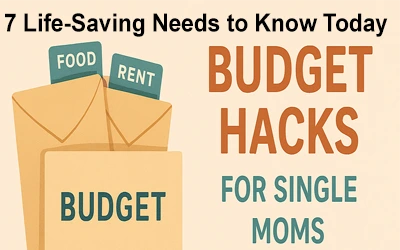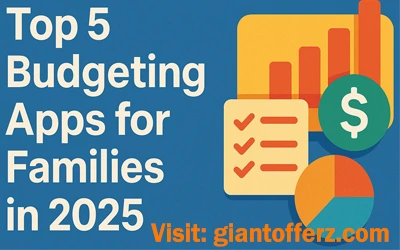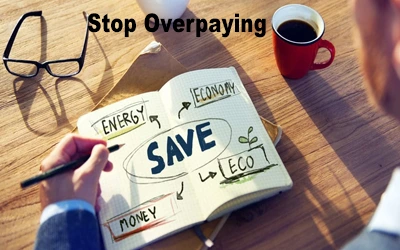
Emergency Fund Tips For Families
How to Build an Emergency Fund When You're Already Broke
Let’s be brutally honest…
Most advice on saving money sounds like it’s written for people who already have money. But what if you’re already broke? What if you’re choosing between groceries and gas?
If you’re a parent, the stress is worse. You’re not just worrying about yourself—you’re protecting little ones who depend on you.
And in America today, with rising prices and unstable jobs, one small surprise can break a family financially.
But there’s hope.
First of all, In this no-fluff guide, you’ll learn exactly how to build an emergency fund from zero—even if you’re living paycheck to paycheck. Every section below is carefully designed to trigger your mind emotionally, show you real tactics, and build confidence through small wins.
Let’s start where most families are right now: rock bottom. Because from there, the only way is up.
Emergency Fund Tips For Families
What Is an Emergency Fund—and Why Every Family Needs It NOW
An emergency fund is more than just money.
It’s the difference between:
- Sleeping in peace vs. panic at 3 a.m.
- Keeping your home vs. facing eviction
- Paying for your child’s prescription vs. maxing out a credit card
Definition:
An emergency fund is a stash of cash specifically set aside to cover sudden and unexpected financial crises—without going into debt.
But here’s what most forget:
It’s not just for the worst-case scenario. It’s for life. Because life is unpredictable, and as a parent, you have to be the predictable one.
Why You Feel Stuck (And Why It’s Not Your Fault)
If saving feels impossible, there are good reasons:
- You’re underpaid
- Inflation is crushing your spending power
- Your expenses rise faster than your income
- Debt drains your check before it lands
But you know what truly keeps families stuck?
- Mental burnout from living on the edge for too long.
- Shame from not saving enough.
- The myth that only “rich” people can save.
The truth?
Even $5/week rewires your psychology. It breaks the cycle of fear and starts building financial dignity.
“It’s not the size of the savings, but the strength of the decision to start.”
How to Build an Emergency Fund on Low Income
How Much Emergency Savings Do You Really Need? (Tiered Plan)
Let’s make this manageable.
Family Type | Minimum Goal | Strong Safety Net |
Single parent | $250–$500 | $1,500–$2,000 |
2 adults + 1 kid | $500–$1,000 | $3,000–$5,000 |
2+ kids | $1,000–$2,000 | $5,000–$8,000 |
Self-employed | $2,000–$3,000 | 3 months of income |
Start with a target like $300.
Why? Because it’s reachable. And hitting that first goal builds momentum, which is more valuable than the money itself.
Why Emergency Funds Work
Emergency funds aren’t just about cash. They affect:
- Stress levels
- Marital relationships
- Decision-making during crisis
- Children’s emotional stability
Studies show that even $250 in savings can reduce financial anxiety by over 50%.
Think about it: When the car breaks down, would you rather use a credit card and add interest—or have $300 ready to go?
Having a fund makes you decisive in chaos, not panicked. That changes how your family sees you.
It changes how you see yourself.
Emergency Fund Tips For Families
How to Start Saving When You're Flat Broke
Here’s what most blogs don’t do:
Give specific, realistic steps for broke families.
So here’s your real plan:
1. Cut Emotion-Driven Spending Without Feeling Deprived
Don’t cancel everything—cancel the right things.
Examples:
- Keep $5/month Spotify, but cancel $60 cable
- Cut one restaurant meal/month = $40 saved
- Switch to generic meds = $10–$30/mo saved
Use that saved amount immediately toward your emergency fund.
Saving is more about what you cut out emotionally than what you earn.
2. Bank Your Change Automatically
Apps like:
- Acorns
- Qapital
- Chime
Let you round-up purchases and save the difference automatically.
Buy coffee for $3.25? It rounds to $4 and deposits $0.75.
Let this run in the background while you hustle in the foreground.
3. Turn Trash into Cash (Micro Hustles for Families)
Got old baby gear, kitchen items, tools?
List them on:
- Facebook Marketplace
- OfferUp
- Mercari
Even one sale/week = $40–$100 = emergency gold.
Pro tip: Involve your kids. Teach them to price, post, and sell. You’re building savers and creators.
4. The $5–$10 Bill Envelope Game
Every $5 or $10 bill you touch—don’t spend it. Save it.
Psychologically, smaller denominations feel easier to part with. After one month, many families save $60–$120 this way.
5. Side-Income That Doesn’t Require Degrees or Driving
- Microtasks (Clickworker, InboxDollars, PrizePursuit)
- Babysitting 1 evening/week
- Cleaning help 2 hours on weekends
- Selling baked goods to neighbors
Even $25/week from these = $100/month
👉 That’s $1,200/year — nearly half of a strong emergency fund!
Best Savings Plans for Unexpected Expenses
Turn Your Tax Refund Into A Survival Fund—Not A Shopping Spree
Every year, many families across the US receive tax refunds, stimulus payments, or credits like the Child Tax Credit or Earned Income Tax Credit. It feels like a little bonus, a chance to treat yourself after tough months.
But honestly, if you spend it all right away, you’re just delaying the stress. That money can really make a difference if you plan it right.
Here’s a simple rule that helped me and many others:
Spend about 20% on something that makes you happy — a small treat, a night out, whatever keeps you motivated. But save the rest — around 80% — to build your emergency fund.
Think about it. That 80% could cover a couple of months’ bills if an emergency hits. It’s not about denying yourself fun; it’s about balancing your needs and your future security.
Try to have your refund go straight into your savings account if you can. It helps stop temptation from spending it before you save.
If you break your refund into chunks — say 20% for fun, 30% for bills, and 50% for savings — you’ll feel more in control and less stressed later on. And over time, it builds up a safety net that’s hard to break.
Create an Emergency Fund Challenge With Your Kids
Saving money doesn’t have to be a drag — especially if you get your kids involved. Turning it into a game or family project can actually make saving fun and meaningful.
Try this: get a sticker chart and every time the family adds $10 to the emergency fund, add a sticker. Celebrate small wins! Maybe when you hit $100, have a family pizza night or movie marathon.
Tell your kids the goal is to save for “safety, not stuff.” It’s a simple way to teach them why saving matters — it’s not about buying toys but about feeling safe and prepared.
Getting your kids involved helps them feel proud and responsible. It builds patience and teamwork, and they learn early that money is about freedom, not fear.
You can even have them save part of their allowance or gifts toward the fund. When they see everyone working together, saving stops feeling like a chore and becomes a family mission.
Where to Keep Emergency Savings for Quick Access (But Not Temptation)
Safe spots:
- Online high-yield savings account (Ally, Capital One, CIT Bank)
- Locked sub-accounts in Chime or Qapital
- Prepaid debit card with no ATM access
Avoid:
- Keeping it with your main checking account
- Physical cash unless secured in a lockbox
Tip: Rename your savings account to:
- “Family Security Fund”
- “Rainy Day Lifeline”
- “Emergency Power Vault”
Psychology matters. Naming creates ownership.
Get a $1000 Cash Voucher – Start Your Emergency Fund With Real Money
- You’ve read this far because you’re serious.
- You want control.
- You want peace.
- You want to protect your family from uncertainty.
Here’s your shortcut.
Right now, you can claim up to $1,000 in a real cash reward through selected partner platforms.
These companies offer sponsored rewards for trying:
- Prepaid cards
- Budgeting tools
- Financial apps
- Grocery rebate memberships
What Can You Do With a $1000 Cash Voucher?
Getting a $1000 cash voucher might sound too good to be true, especially when money is tight. But imagine this: one smart decision today could give you a $1000 head start on your emergency fund, without dipping into your paycheck.
So, what can you really do with this voucher?
1. Cover Unexpected Bills
Medical emergencies, urgent car repairs, or last-minute travel for family—all these can drain your finances quickly. A $1000 voucher can cover many of these costs, giving you breathing room when it matters most.
2. Buy Essential Supplies
Stock up on groceries, baby formula, medications, or even utilities bills. Having this voucher means you won’t have to choose between necessities and saving.
3. Pay Down High-Interest Debt
If you’re juggling credit cards or payday loans, using the voucher to reduce those balances can save you hundreds in interest fees over time. This step actually makes your money work smarter, not harder.
4. Invest in a Side Hustle
Use part of the voucher to buy materials or tools for a small home business—maybe crafting, baking, or freelancing tools. Turning a voucher into income-generating assets can multiply its value many times over.
Emergency Fund Tips For Families
Why Trust This Offer?
- This voucher comes from verified, reputable partners working with trusted financial platforms.
- It’s not a loan or credit—there’s no repayment needed.
- Many families across the US have already claimed these vouchers and used them to transform their financial situations.
- The application process is simple and transparent, designed to protect your personal information and make claiming easy.
How It Works:
- Click “Claim The $1000 Cash Reward” button below to unlock the reward portal
- Sign up using real credentials
- Complete the steps (like downloading an app or requesting a card)
- Get paid. Many families see payouts in 2–3 days.
👉 This isn’t a handout. This is your head start.
People Also Ask
Q. How can low-income families build an emergency fund from scratch?
Answer: Let’s be real—it’s tough when you’re already stretched thin. But saving something, even just a little, is better than nothing. One idea? Start by tracking your spending for a week. You’ll be surprised—maybe that $3 snack or random app fee is showing up more often than you thought. Cut one small thing, and try setting aside just $5 or $10 each week.
Q. What's the smartest way to use a tax refund for financial stability?
Answer: Here’s the deal—your tax refund isn’t a bonus, it’s your money coming back. Don’t treat it like lottery cash. Instead, break it up: maybe 20% for a personal treat, and put the rest toward an emergency fund. That way, one refund can buy you 2–3 months of peace if something goes wrong. You’ll thank yourself later when life throws surprises your way.
Q. Are cash vouchers like the $1000 offer real and safe to use?
Answer: It depends where you get them from. Some $1000 cash voucher programs are legit—especially those tied to verified partners, banks, or financial apps. But here’s the thing: always read the fine print, check reviews, and never pay upfront. If it requires you to try a free trial or install a secure app, that’s normal—but don’t give out your bank login. Use a prepaid card when possible.
Q. What should I prioritize: debt payments or emergency savings?
Answer: Honestly? You need both. But here’s a trick—build at least a small buffer first. Having $500 stashed for emergencies means you won’t have to swipe a credit card for a surprise expense. Once you’ve got that, throw extra at high-interest debt. Think of it like wearing a seatbelt before you start driving fast.
Q. Can I build an emergency fund while on unemployment?
Answer: Yes, but it takes planning. First, cut all non-essentials—subscriptions, upgrades, eating out. Use community support (like food pantries) to redirect cash into savings. If you receive unemployment benefits, try using 10–15% strictly for savings. Even gig apps or small online tasks can supplement that. It’s about discipline, not just income.
Q. How can I teach kids about emergency savings?
Answer: Make it visual and fun. Use a clear jar or a sticker chart so they see savings grow. Give them a small allowance and let them choose to “save for safety” vs “spend on stuff.” When they hit savings goals, do a small family celebration. It’s about making saving feel like a win, not a punishment.
Q. Are emergency fund apps worth using for families?
Answer: Definitely. Apps like Qapital, Chime, or Albert let you automate tiny savings—like rounding up change. For busy families, automation is a lifesaver. You won’t miss the money, and the balance grows quietly in the background. It’s one less thing to think about, and one more step toward security.
Q. How do I mentally stay motivated to save when I’m broke?
Answer: Honestly, it’s draining trying to save when you’re just trying to survive. But think of savings as your future self’s freedom. Even $5 saved is $5 you won’t have to borrow under pressure. Use reminders on your phone like “This $10 = peace next month.” Small mindset shifts matter more than big paychecks sometimes.
Q. Can a $1000 emergency fund actually make a difference?
Answer: Absolutely. It won’t solve every crisis, but it buys time. One thousand dollars can cover rent delays, fix a flat tire, or pay a medical copay—things that could otherwise push you into debt. It’s not about the amount, it’s about control. It helps you respond, not react.
Q. What kind of bank account is best for emergency savings?
Answer: Don’t overthink it—what you need is a place to park your money safely where it won’t tempt you. A simple online savings account (like with Capital One or Ally) is a solid choice. They usually offer better interest than big-name banks and no silly monthly fees.
Make sure it’s separate from your main checking. That way, you won’t see it every day and feel like spending it. But also make sure you can get to it quickly if something serious happens—car trouble, medical bill, stuff like that. Keep it boring, safe, and slightly out of reach. That’s the sweet spot.
Final Thoughts – This Is About More Than Money
Money can’t solve every problem.
But a lack of money? That solves nothing.
An emergency fund isn’t a luxury for rich people—it’s a necessity for families like yours.
You’ve already survived paycheck-to-paycheck life. That proves you’re tough.
Now it’s time to prove you’re also strategic.
Start today. Even if it’s just $5.
Because the real emergency.
is waiting until it’s too late.
Emergency Budgeting Strategies for Families
Financial Preparedness for Working Parents
Save for Emergencies Without Cutting Essentials
How Much Emergency Savings Do I Need
Family Emergency Fund Calculator Guide
Emergency Fund Mistakes to Avoid
In real family scenarios,
Emergency Fund Tips For Families, Get Emergency Fund Tips For Families, How to get Emergency Fund Tips For Families,



